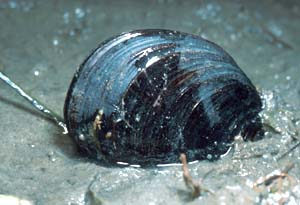|
|

Edible Mussel, Mytilus edulus planulatus
Form:
The Edible Mussel's shell is wedge-shaped, broad and thick, with umbos at the anterior end.
The shell halves are sharply pointed at the hinged end, and extremely broad and rounded at the posterior end. The sculpture is mostly smooth, except for concentric radial growth lines and some very fine radial scratches. The covering peristracum is thick.
Colour:
The shell colour is bluish-black to dark brown. Juveniles are always brown. The interior of this bivalve is bluish-white. The covering periostracum is dark olive-brown.
Phylum: |
Mollusca |
Author: |
Lamarck, 1819 |
Family: |
Mytilidae |
Size: |
50-120 mm |
Distribution:
 The
Edible Mussel occurs from New South Wales around the southern Australian
coastline to southern Western Australia.
The
Edible Mussel occurs from New South Wales around the southern Australian
coastline to southern Western Australia.
Habitat:
This mussel occurs intertidally, often preferring quiet, moist gutters, down to 15 metres, on shores of low to moderate wave energy. It is also found in great numbers on jetty piles in sheltered areas.
Biology:
This is the commercial edible mussel sold for food in southern Australia. It may be eaten raw or boiled. It is also used as bait for fishing. The Pea Crab, Pinotheres hickmani, may be found living its full life within these mussel shells.
References:
In some Australian reference books this mussel is called Mytilus planulatus.
Bennett, I. (1987) W. J. Dakin's classic study: Australian Seashores. p. 215, Angus & Robertson, Sydney.
Davey, K. (1998) A Photographic Guide to Seashore Life of Australia. p. 122, New Holland, Sydney.
Edgar, G. J. (1997) Australian Marine Life: the plants and animals of temperate waters. p.286 Reed Books, Kew.
Marine Research Group of Victoria (1984) Coastal Invertebrates of Victoria: an atlas of selected species. p. 38, Museum of Victoria, Melbourne.
Macpherson, J. H. & Gabriel, C. J. (1962) Marine Molluscs of Victoria. p. 293, Melbourne University Press & The National Museum of Victoria.
Shepherd, S. A. & Thomas, I. M. (1982) Marine Invertebrates of Victoria, Pt. 2.p. 632, South Australian Government Printer, Adelaide.
Edible
Mussel
Little Black Horse Mussel
Commercial
Oyster
Home
Page
Taxonomy
Biogeography
Rocky Shores
Tidal Levels
Intertidal Zonation
Environmental Factors
Biological
Factors
Feeding Relationships
Activities
Glossary
References
 Life
on Australian Seashores
Life
on Australian Seashores
by Keith Davey (C) 2000
Learning Consultant
- Media
The University of Newcastle
email at australian_seashores@hotmail.com
Scientific Consultant: Phil
Colman
site created 01.01.98 : updated 01.04.2000
